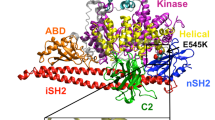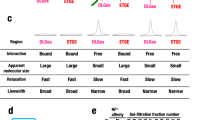Abstract
Members of the novel SH2-containing protein (NSP3) and Crk-associated substrate (p130Cas) protein families form a multi-domain signalling platforms that mediate cell signalling process. We analysed the damaging consequences of three mutations, each from NSP3 (NSP3L469R, NSP3L623E, NSP3R627E) and p130Cas (p130CasF794R, p130CasL787E, p130CasD797R) protein with respect to their native biological partners. Mutations depicted notable loss in interaction affinity towards their corresponding biological partners. NSP3L469R and p130CasD797R mutations were predicted as most prominent in docking analysis. Molecular dynamics (MD) studies were conducted to evaluate structural consequences of most prominent mutation in NSP3 and p130Cas obtained from the docking analysis. MD analysis confirmed that mutation in NSP3L469R and p130CasD797R showed significant structural deviation, changes in conformations and increased flexibility, which in turn affected the binding affinity with their biological partners. Moreover, the root mean square fluctuation has indicated a rise in fluctuation of residues involved in moderate interaction acquired between the NSP3 and p130Cas. It has significantly affected the binding interaction in mutant complexes. The results obtained in this work present a detailed overview of molecular mechanisms involved in the loss of cell signalling associated with NSP3 and p130Cas protein.










Similar content being viewed by others
Abbreviations
- BCAR1:
-
Breast cancer anti-oestrogen resistance protein 1
- BSA:
-
Buried surface area
- Crk:
-
Cysteine-rich receptor like kinases
- FAT:
-
Focal adhesion target
- Rg:
-
Radius of gyration
- SASA:
-
Solvent accessible surface area
References
Kholodenko, B. N. (2006). Cell signalling dynamics in time and space. Nature Reviews Molecular Cell Biology, 7, 165–176.
Mace, P. D., Wallez, Y., Dobaczewska, M. K., et al. (2011). NSP-Cas protein structures reveal a promiscuous interaction module in cell signaling. Nature Structural & Molecular Biology, 18, 1381–1387.
Bargon, S. D., Gunning, P. W., & O’Neill, G. M. (2005). The Cas family docking protein, HEF1, promotes the formation of neurite-like membrane extensions. Biochimica et Biophysica Acta, 1746, 143–154.
Hauck, C. R., Hsia, D. A., Puente, X. S., Cheresh, D. A., & Schlaepfer, D. D. (2002). FRNK blocks v-Src-stimulated invasion and experimental metastases without effects on cell motility or growth. The EMBO Journal, 21, 6289–6302.
Brábek, J., Constancio, S. S., Siesser, P. F., et al. (2005). Crk-associated substrate tyrosine phosphorylation sites are critical for invasion and metastasis of SRC-transformed cells. Molecular Cancer Research, 3, 307–315.
Sakakibara, A., Ohba, Y., Kurokawa, K., Matsuda, M., & Hattori, S. (2002). Novel function of chat in controlling cell adhesion via Cas-Crk-C3G-pathway-mediated Rap1 activation. Journal of Cell Science, 115, 4915–4924.
Honda, H., Nakamoto, T., Sakai, R., & Hirai, R. (1999). p130(Cas), an assembling molecule of actin filaments, promotes cell movement, cell migration, and cell spreading in fibroblasts. Biochemical and Biophysical Research Communications, 262, 25–30.
Garron, M. L., Arsenieva, D., Zhong, J., et al. (2009). Structural insights into the association between BCAR3 and Cas family members, an atypical complex implicated in anti-oestrogen resistance. Journal of Molecular Biology, 386, 190–203.
Al-Shami, A., Wilkins, C., Crisostomo, J., Seshasayee, D., Martin, F., Xu, N., et al. (2010). The adaptor protein sh2d3c is critical for marginal zone B cell development and function. Journal of Immunology, 185, 327–334.
Tikhmyanova, N., Little, J. L., & Golemis, E. A. (2010). CAS proteins in normal and pathological cell growth control. Cellular and Molecular Life Sciences, 67, 1025–1048.
Browne, C. D., Hoefer, M. M., Chintalapati, S. K., et al. (2010). SHEP1 partners with CasL to promote marginal zone B-cell maturation. Proceedings of the National Academy of Sciences of the United States of America, 107, 18944–18949.
Borre, P. V., Near, R. I., Makkinje, A., Mostoslavsky, G., & Lerner, A. (2011). BCAR3/AND-34 can signal independent of complex formation with CAS family members of the presence of p130Cas. Cell Signalling, 23, 1030–1040.
Klemke, R. L., Leng, J., Molander, R., et al. (1998). CAS/Crk coupling serves as a ‘molecular switch” for induction of cell migration. Journal of Cell Biology, 140, 961–972.
Rajendran, V., Purohit, R., & Sethumadhavan, R. (2012). In silico investigation of molecular mechanism of laminopathy cause by a point mutation (R482 W) in lamin A/C protein. Amino Acids, 43, 603–615.
Purohit, R., Rajendran, V., & Sethumadhavan, R. (2011). Studies on adaptability of binding residues and flap region of TMC-114 resistance HIV-1 protease mutants. Journal of Biomolecular Structure & Dynamics, 29, 137–152.
Purohit, R., & Sethumadhavan, R. (2009). Structural basis for the resilience of Darunavir (TMC114) resistance major flap mutations of HIV-1 protease. Interdisciplinary Reviews, 1, 320–328.
Purohit, R., Rajendran, V., & Sethumadhavan, R. (2011). Relationship between mutation of serine residue at 315th position in M. tuberculosis catalase-peroxidase enzyme and isoniazid susceptibility: An in silico analysis. Journal of Molecular Modelling, 17, 869–877.
Purohit, R., Rajasekaran, R., Sudandiradoss, C., et al. (2008). Studies on flexibility and binding affinity of Asp25 of HIV-1 protease mutants. International Journal of Biological Macromolecules, 42, 386–391.
Kumar, A., & Purohit, R. (2012). Computational investigation of pathogenic nsSNPs in CEP63 protein. Gene, 503, 75–82.
Kumar, A., & Purohit, R. (2012). Computational screening and molecular dynamics simulation of disease associated nsSNPs in CENP-E. Mutation Research, 738–739, 28–37.
Balu, K., & Rituraj, P. (2013). Mutational analysis of TYR gene and its structural consequences in OCA1A. Gene, 513, 184–195.
Kumar, A., Rajendran, V., Sethumadhavan, R., & Purohit, R. (2012). In silico prediction of a disease-associated STIL mutant and its affect on the recruitment of centromere protein J (CENPJ). FEBS Open Biology, 2, 285–293.
Kumar, A., & Purohit, R. (2012). Computational centrosomics: An approach to understand the dynamic behaviour of centrosome. Gene, 511, 125–126.
Berman, H. M., Westbrook, J., Feng, Z., et al. (2000). The protein data bank. Nucleic Acids Research, 28, 235–242.
Kaplan, W., & Littlejohn, T. G. (2001). Swiss-PDB viewer (deep view). Briefings in Bioinformatics, 2, 195–197.
Hess, B., Kutzner, C., Spoel, D. V. D., & Lindahl, E. (2008). GROMACS 4: Algorithms for highly efficient, load-balanced, and scalable molecular simulation. Journal of Chemical Theory and Computation, 4, 435–447.
Dominguez, C., Boelens, R., & Bonvin, A. M. (2003). HADDOCK: A protein–protein docking approach based on biochemical or biophysical information. Journal of the American Chemical Society, 125, 1731–1737.
de Vries, S. J., van Dijk, M., & Bonvin, A. M. J. J. (2010). The HADDOCK web server for data driven biomolecular docking. Nature Protocols, 5, 883–897.
Nilges, M. (1995). Calculation of protein structures with ambiguous distance restraints. Automated assignment of ambiguous NOE crosspeaks and disulphide connectivities. Journal of Molecular Biology, 245, 645–660.
Nilges, M., Macias, M. J., O’Donoghue, S. I., & Oschkinat, H. (1997). Automated NOESY interpretation with ambiguous distance restraints: The refined NMR solution structure of the pleckstrin homology domain from beta-spectrin. Journal of Molecular Biology, 269, 408–422.
Brunger, A. T., Adams, P. D., Clore, G. M., et al. (1998). Crystallography & NMR system: A new software suite for macromolecular structure determination. Acta Crystallographica. Section D, Biological Crystallography, 54, 905–921.
Wallace, A. C., Laskowski, R. A., & Thornton, J. M. (1995). LIGPLOT: A program to generate schematic diagrams of protein-ligand interactions. Protein Engineering, 8, 127–134.
McDonald, I. K., & Thornton, J. M. (1994). Satisfying hydrogen bonding potential in proteins. Journal of Molecular Biology, 238, 777–793.
Berendsen, H. J. C., Postma, J. P. M., van Gunsteren, W. F., et al. (1984). Molecular dynamics with coupling to an external bath. The Journal of Chemical Physics, 8, 3684–3690.
Cheatham, T. E, I. I. I., Miller, J. L., Fox, T., et al. (1995). Molecular dynamics simulations on solvated biomolecular systems: The particle mesh Ewald method leads to stable trajectories of DNA, RNA, and proteins. Journal of the American Chemical Society, 14, 4193–4194.
Turner, P. J. (2005). XMGRACE, version 5. 1. 19. Beaverton, OR: Center for Coastal and Land-Margin Research, Oregon Graduate Institute of Science and Technology.
Amadei, A., Linssen, A. B., & Berendsen, H. J. C. (1993). Essential dynamics of proteins. Proteins, 17, 412–425.
Halperin, I., Ma, B., Wolfson, H., & Nussinov, R. (2002). Principle of docking: An overview of search algorithms and a guide to scoring functions. Proteins, 47, 409–443.
Janin, J., Henrick, K., Moult, J., et al. (2003). CAPRI: A critical assessment of predicted interactions. Proteins, 52, 2–9.
Dijk, M. V., Dijk, A. D. V., Hsu, V., et al. (2006). Information-driven protein-DNA docking using HADDOCK: It is a matter of flexibility. Nucleic Acids Research, 34, 3317–3325.
Teng, S., Madej, T., Panchenko, A., & Alexov, E. (2009). Modelling effects of human single nucleotide polymorphisms on protein–protein interactions. Biophysical Journal, 96, 2178–2188.
Zhang, Z., Norris, J., Schwartz, C., & Alexov, E. (2011). In silico and in vitro investigations of the mutability of disease-causing missense mutation sites in spermine synthase. PLoS ONE, 6(5), e20373.
Fersht, A. R. (1984). Basis of biological specificity. Trends in Biochemical Sciences, 9, 145–147.
Honig, B., & Yang, A. S. (1995). Free energy balance in protein folding. Advances in Protein Chemistry, 46, 27–58.
Bartlett, P. A., & Marlowe, C. K. (1987). Evaluation of the intrinsic binding energy from hydrogen bonding group in an enzyme inhibitor. Science, 235, 569–571.
Gao, J., Mammen, M., & Whitesides, G. M. (1996). Evaluating electrostatic contributions to binding with the use of protein charge ladders. Science, 272, 535–537.
Kumar, A., Rajendran, V., Sethumadhavan, R., & Purohit, R. (2013). Computational investigation of cancer-associated molecular mechanism in Aurora A (S155R) mutation. Cell Biochemistry and Biophysics,. doi:10.1007/s12013-013-9524-9.
Rajendran, V., & Sethumadhavan, R. (2013). Drug resistance mechanism of PncA in mycobacterium tuberculosis. Journal of Biomolecular Structure & Dynamics,. doi:10.1080/07391102.2012.759885.
Acknowledgments
Authors gratefully acknowledge the management of Vellore Institute of Technology University for providing the facilities to carry out this work. We thank the anonymous reviewers for their helpful comments and critical reading of the manuscript.
Conflict of interest
Authors have no potential conflict of interest to disclose.
Author information
Authors and Affiliations
Corresponding author
Electronic supplementary material
Below is the link to the electronic supplementary material.
Rights and permissions
About this article
Cite this article
Balu K., Rajendran, V., Sethumadhavan, R. et al. Investigation of Binding Phenomenon of NSP3 and p130Cas Mutants and Their Effect on Cell Signalling. Cell Biochem Biophys 67, 623–633 (2013). https://doi.org/10.1007/s12013-013-9551-6
Published:
Issue Date:
DOI: https://doi.org/10.1007/s12013-013-9551-6




